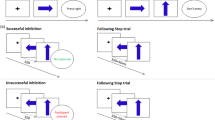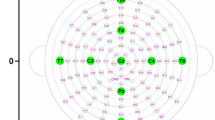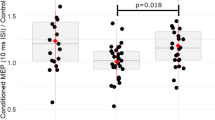Abstract
The N100 component, evoked by transcranial magnetic stimulation (TMS) and electroencephalography is associated with the activation of inhibitory cortical circuits and has recently been suggested as a potential marker of inhibition in attention-deficit/hyperactivity disorder (ADHD). The aim of the present ADHD study was to investigate the modulation of the TMS-N100 in go and nogo trials of a response control task considering stages of response preparation, activation, execution and inhibition. Eighteen children with ADHD and 19 typically developing children, aged 10–14 years, were assessed. TMS was delivered over the left motor cortex, the TMS-N100 was measured at electrode P3. The TMS-N100 was determined at rest and at different time points (50 ms before S2; 150, 300 and 500 ms after S2) in a cued go/nogo task (S1–S2 paradigm). Correlations between the TMS-N100 measures, MEP-related TMS measures (e.g., short-interval intracortical inhibition) and performance measures were calculated. At rest, the amplitude of TMS-N100 was not found to be significantly reduced in the ADHD group. During the go/nogo task, children with ADHD showed a smaller increase of TMS-N100 amplitude in go trials and a smaller decrease after inhibiting a response. In go trials, a lower TMS-N100 was associated with a smaller variability of reaction times. A smaller TMS-N100 modulation extends the picture of cortical inhibition deficits in ADHD. Findings suggest a functional involvement of the mechanisms underlying the TMS-N100 at the motor output stage.




Similar content being viewed by others
Notes
Analyzing the TMS-N100 at P3 for the data of Bruckmann et al. (2012), the difference between children with ADHD and TD children was close to a trend (Bender, personal communication).
References
Bender S, Basseler K, Sebastian I, Resch F, Kammer T, Oelkers-Ax R et al (2005) Electroencephalographic response to transcranial magnetic stimulation in children: evidence for giant inhibitory potentials. Ann Neurol 58:58–67
Bonnard M, Spieser L, Meziane HB, de Graaf JB, Pailhous J (2009) Prior intention can locally tune inhibitory processes in the primary motor cortex: direct evidence from combined TMS-EEG. Eur J Neurosci 30:913–923
Bruckmann S, Hauk D, Roessner V, Resch F, Freitag CM, Kammer T et al (2012) Cortical inhibition in attention deficit hyperactivity disorder: new insights from the electroencephalographic response to transcranial magnetic stimulation. Brain 135:2215–2230
Buchmann J, Wolters A, Haessler F, Bohne S, Nordbeck R, Kunesch E (2003) Disturbed transcallosally mediated motor inhibition in children with attention deficit hyperactivity disorder (ADHD). Clin Neurophysiol 114:2036–2042
Cohen JD (1988) Statistical power analysis for the behavioral sciences, 2nd edn. Erlbaum, Hillsdale
Curatolo P, D′Agati E, Moavero R (2010) The neurobiological basis of ADHD. Ital J Pediatr 22:36–79
Daskalakis ZJ, Farzan F, Barr MS, Maller JJ, Chen R, Fitzgerald PB (2008) Long-interval cortical inhibition from the dorsolateral prefrontal cortex: a TMS-EEG study. Neuropsychopharmacology 33:2860–2869
Di Lazzaro V, Pilato F, Dileone M, Ranieri F, Ricci V, Profice P (2006) GABAA receptor subtype specific enhancement of inhibition in human motor cortex. J Physiol 575:721–726
Döpfner M, Lehmkuhl G (2000) DISYPS-KJ – Diagnostik-System für psychische Störungen im Kindes- und Jugendalter. Hans Huber, Bern
Gilbert DL, Isaacs KM, Augusta M, MacNeil LK, Mostofsky SH (2011) Motor cortex inhibition: a marker of ADHD behavior and motor development in children. Neurology 760:615–621
Gratton G, Coles MG, Donchin E (1983) A new method for off-line removal of ocular artifact. Electroencephalogr Clin Neurophysiol 55:468–484
Hoegl T, Heinrich H, Barth W, Lösel F, Moll GH, Kratz O (2012) Time course analysis of motor excitability in a response inhibition task according to the level of hyperactivity and impulsivity in children with ADHD. PLoS ONE 7:e46066. doi:10.1371/journal.pone.0046066
Heinrich H, Hoegl T, Moll GH, Kratz O. A combined ERP/TMS study of motor control: a step towards the core mechanisms of ADHD? (submitted)
Kähkönen S, Kesäniemi M, Nikouline VV, Karhu J, Ollikainen M, Holi M et al (2001) Ethanol modulates cortical activity: direct evidence with combined TMS and EEG. NeuroImage 14:322–328
Komssi S, Aronen HJ, Huttunen J, Kesäniemi M, Soinne L, Nikouline VV et al (2002) Ipsi- and contralateral EEG reactions to transcranial magnetic stimulation. Clin Neurophysiol 113:175–184
Kratz O, Diruf MS, Studer P, Gierow W, Buchmann J, Moll GH, Heinrich H (2009) Effects of methylphenidate on motor system excitability in a response inhibition task. Behav Brain Funct 5:12. doi:10.1186/1744-9081-5-12
Kratz O, Studer P, Barth W, Wangler S, Hoegl T, Heinrich H et al (2011) Seizure in a nonpredisposed individual induced by single-pulse transcranial magnetic stimulation. J ECT 27:48–50
Kujirai T, Caramia MD, Rothwell JC, Day BL, Thompson PD, Ferbert A et al (1993) Corticocortical inhibition in human motor cortex. J Physiol 471:501–519
Leocani L, Cohen LG, Wassermann EM, Ikoma K, Hallett M (2000) Human corticospinal excitability evaluated with transcranial magnetic stimulation during different reaction time paradigms. Brain 123:1161–1173
Moll GH, Heinrich H, Trott G, Wirth S, Rothenberger A (2000) Deficient intracortical inhibition in drug-naive children with attention-deficit hyperactivity disorder is enhanced by methylphenidate. Neurosci Lett 284:121–125
Moll GH, Heinrich H, Rothenberger A (2002) Transcranial magnetic stimulation in child psychiatry: disturbed motor system excitability in hypermotoric syndromes. Dev Sci 5:381–391
Nikouline V, Ruohonen J, Ilmoniemi RJ (1999) The role of the coil click in TMS assessed with simultaneous EEG. Clin Neurophysiol 110:1325–1328
Nikulin VV, Kicić D, Kähkönen S, Ilmoniemi RJ (2003) Modulation of electroencephalographic responses to transcranial magnetic stimulation: evidence for changes in cortical excitability related to movement. Eur J Neurosci 18:1206–1212
Paus T, Sipila PK, Strafella AP (2001) Synchronization of neuronal activity in the human primary motor cortex by transcranial magnetic stimulation: an EEG study. J Neurophysiol 86:1983–1990
Polanczyk G, de Lima MS, Horta BL, Biederman J, Rohde LA (2007) The worldwide prevalence of ADHD: a systematic review and metaregression analysis. Am J Psychiatry 164:942–948
Reis J, Swayne OB, Vandermeeren Y, Camus M, Dimyan MA, Harris-Love M et al (2008) Contribution of transcranial magnetic stimulation to the understanding of cortical mechanisms involved in motor control. J Physiol 586:325–351
Rogasch NC, Daskalakis ZJ, Fitzgerald PB (2013) Mechanisms underlying long-interval cortical inhibition in the human motor cortex: a TMS-EEG study. J Neurophysiol 109:89–98
Sohn YH, Wiltz K, Hallett M (2002) Effect of volitional inhibition on cortical inhibitory mechanisms. J Neurophysiol 88:333–338
Sonuga-Barke EJ (2002) Psychological heterogeneity in AD/HD - a dual pathway model of behaviour and cognition. Behav Brain Res 130:29–36
Willcutt EG, DeFries JC, Pennington BF, Olson RK, Smith SD, Cardon LR (2003) Genetic etiology of comorbid reading difficulties and ADHD. In: Plomin R, DeFries JC, McGuffin P, Craig I (eds) Behavioral genetics in a postgenomic era. American Psychological Association, Washington D.C., pp 227–246
Ziemann U, Tergau F, Bruns D, Baudewig J, Paulus W (1997) Changes in human motor cortex excitability induced by dopaminergic and anti-dopaminergic drugs. Electroencephalogr Clin Neurophysiol 105:430–437
Author information
Authors and Affiliations
Corresponding author
Rights and permissions
About this article
Cite this article
D’Agati, E., Hoegl, T., Dippel, G. et al. Motor cortical inhibition in ADHD: modulation of the transcranial magnetic stimulation-evoked N100 in a response control task. J Neural Transm 121, 315–325 (2014). https://doi.org/10.1007/s00702-013-1097-7
Received:
Accepted:
Published:
Issue Date:
DOI: https://doi.org/10.1007/s00702-013-1097-7




